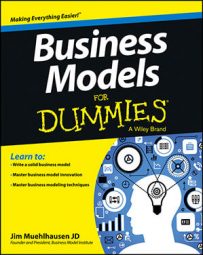They’re called innovations for a reason. Great ideas rarely are in the mainstream or are conformist. Some of the best ways to innovate a business model come from unusual or counterintuitive means. Here are ten ways you can buck convention and innovate your business model.
Engage in activities your competitors won’t
It’s easy to have competitive advantage when you have no competitors. If everyone else is afraid to try something, it could be a valuable opportunity. Examples include extreme guarantees, customer self-service, and freemiums (a product or service that is free, but users pay for advanced features).
Hire the buyer as an exit strategy
Can’t find a viable exit strategy? Don’t worry; hire a talented person with the raw talent to run your business and teach her the rest. While she’s learning the business, you get a trial run to see whether she’s capable of being the boss.
Throw the vendor into the shark tank
Many industries have vendors clamoring for customers. This supply-and-demand imbalance gives the buyer (you) the upper hand. Create transparency in the buying process by making everything public. Let each vendor know the pricing and terms of its competition. Expose the details of each bid on the Internet. Send a mass quote request to all vendors with a listing of all companies who are invited to bid. Make any major purchase like a reverse eBay auction and you’ll lower your cost basis and improve your business model.
Hire two salespeople at once in a competition
Fact: Most salespeople interview well. Fact: Many salespeople interview better than they sell. By hiring the wrong salesperson, you waste time, money, and effort until you get the right one in place. Speed up the process by hiring two salespeople for one job. Pro football has training camp to see who makes the team; why can’t you? Be transparent and let the candidates know it’s a competition. If they aren’t up for the fight, they aren’t really salespeople.
Shift costs to vendors
Grocery stores make vendors like Frito-Lay stock their shelves. Automotive warehouses make vendors take annual inventories. Toyota’s lean manufacturing makes Toyota more efficient and reduces their inventory. However, the inventory doesn’t disappear; it gets pushed down the vendor channel and gains for Toyota created by vendor inefficiencies. Walmart gives vendors a tiny three-minute window to deliver truckloads of goods. This saves time, money, and planning resources for Walmart but forces trucking companies to waste resources parked in bullpens awaiting their slotted time.
Fire your low-margin customers
All business isn’t good business. Sales volume doesn’t drive the costs of a business — transactions do. Some customers have the knack of making your transaction costs high and your margins low. Consider running a full customer analysis that considers all the costs of doing business with a particular customer versus the margin generated, and then fire the ones who cost more than they generate.
Change to flat-rate pricing when no one else is
Ask a plumber whether he can make more charging by the hour or charging a flat rate. He’ll tell you, “I can make twice as much charging a flat rate.” Flat-rate billing incorporates a business model innovation — selling “insurance” — into pricing. The vendor accepts certain risks in exchange for money — lots of money. Flat-rate pricing includes fixed-cost bids, flat-rate hourly billing, “all you can eat” plans, and simplified pricing such as the post office’s flat rate envelopes that cost the same whether you’re shipping to Alaska or down the street.
Turn waste into cash
One man’s trash is another man’s treasure. The Duraflame log was created from waste wood shavings. Crystal Clean successfully took on industry giant Safety Kleen by disposing of used mineral spirits from customers by selling them to shingle manufacturers who discovered that dirty spirits worked better in their manufacturing process than new spirits.
Do business in a way that makes you more profitable
If your business model relies on a low-cost structure, force (don’t ask) your customers to help you keep costs low. Henry Ford lowered costs by producing only black Model Ts. Aldi supermarkets charge for bags and to rent carts. Southwest Airlines doesn’t allow seat assignments or have first-class seating. Doctors make sick patients come to their offices, schedule appointments to fit the doctor’s needs, wait in a room full of sick people, and then wait until the doctor is available for the privilege of being a customer.
Make your customers do your work
It costs UPS more than $2 to handle a customer service telephone call. If customers service themselves on the web, it costs UPS a quarter. Many restaurants hand you a cup for your soda instead of filling it for you. Banks get you to be your own teller online or at an ATM. In the late 1960s more than 750,000 Americans held jobs as service station attendants — filling the gas tanks of car owners for them. Today, only customers in Oregon and New Jersey enjoy someone else filling their tank for them.
Customers are willing to perform the work traditionally done by employees if the work is at least one of the following:
-
Easy to do (fill your own soda)
-
Faster than waiting on someone to do it for you (looking up your own UPS tracking number)
-
More efficient and reflected in the store’s pricing (Aldi’s bag-your-own groceries)
-
Saves the customer money (post office online stamp printing, online banking)
Leverage this dynamic and enhance your competitive cost advantage and your business model.

